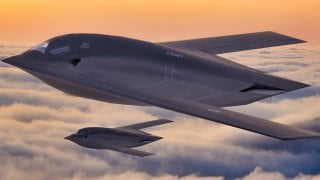The Coming B-21 Raider Stealth Bomber Shortage?
While the B-21 Raider certainly could hit targets in both China and Russia, will the U.S. Air Force build enough of them if a war did break out?
Will America Build Enough B-21 Raider Stealth Bombers to Counter China? - As the potentiality for a conflict between Washington and Beijing over Taiwan seems more likely, both countries will continue racing to achieve air superiority over the other.
While China is putting its money on its fifth-generation Chengdu J-20 fighter and incoming H-20 stealth bombers, the U.S. is quickly developing its Next-Generation Air Dominance (NGAD) program in addition to its own stealth bombers.
Although the B-21 Raider will possess arguably the most advanced capabilities of its kind when introduced, officials and analysts are concerned that not enough of these airframes will be produced to counter China’s growing aerial might.
Introducing the B-21 Raider
The Air Force’s classified Long-Range Strike Bomber dates back to 2011, when the service first requested a new aircraft that could host several critical enhancements to its B-20 predecessor.
By 2015, the contract was awarded by manufacturer Northrop Grumman, who beat out both Boeing and Lockheed Martin.
Ultimately, the Government Accountability Office revealed that Northrop was selected as the winner due to the low costs of its prototype.
When the Raider enters service, it will function as a battle manager, intelligence collection platform, and interceptor aircraft. As summed up by the former Secretary of the Air Force, Deborah Lee James, the B-21 is designed to be a “fifth-generation global precision attack platform.”
An Overview of America’s Bomber Fleet
Currently, the Air Force flies three strategic bombers in its arsenal.
The B-52 Stratofortess has been around for more than six decades. The long-range, subsonic jet-powered strategic bomber can lug up to 70,000 pounds of weapons and fly up to 8,800 miles without aerial refueling.
The B-1B Lancer is newer than the Stratofortress. This variable-sweep wing, heavy bomber was designed to replace both the B-58 Hustler and B-52 when it was first envisioned in the 1960’s.
Northrop Grumman’s B-2 Spirit is the youngest stealth bomber that flies for the Air Force. Featuring low-observable stealth technology, the formidable bomber can penetrate even the densest anti-aircraft defenses. Will this trio is quite menacing, the introduction of the Raider will bring the Air Force’s capabilities to another level.
In terms of form, the Raider is very similar to the B-2, as both airframes utilize a flying wing design. However, rather than sport the classic airframe shape of a fuselage with stabilizers, wings, and a tail attached, the B-21 looks like one massive wing. This unique configuration increased lift while reducing drag. Therefore, less power is needed for the Raider to fly. Additionally, the bomber’s range is increased as it can remain in service for extended periods with needed refueling.
Specs and capabilities for B-21 Raider
On Northrop Grumman’s website, ten capabilities featured by the Raider are highlighted. From stealth and sustainment to global reach and cloud technology, the stealth bomber will be unmatched in the skies. Perhaps the most unique asset being incorporated into the bomber is open architecture.
The B-21 will not have to be taken out of service to receive block upgrades as they come down the line. Instead, newer technologies and weapons can be seamlessly included on the bomber via agile software upgrades and built-in hardware flexibility.
The B-21 Numbers Challenge
Last year, the Air Force revealed that it would procure somewhere between 80-100 B-21s once produced. Analysts and military officials, however, believe this number is sorely low considering the rising threat posed by China.
The Raider is expected to be the sole bomber that can perform direct attacks on targets deep inside Russia and China once in service. The bomber will reportedly clear a path through enemy air defenses for other airframes or attack adversarial ones if necessary. This large task will undoubtedly require more than 80 B-21 Raider airframes.
During the Cold War, the U.S. retained over 400 bombers. Today, that number has shrunk dangerously low to around 141. Even if the Raider is by far the most capable bomber globally when introduced, having an insufficient number of these airframes if kinetic conflict does arise is worrisome.
China is also prioritizing the development of its own next-generation bomber- the H-20.
Although the U.S. appears to be farther ahead in its Raider design and testing process, China does not have to grapple with potential roadblocks of its program in the form of budget constraints.
About the Author
Maya Carlin is an analyst with the Center for Security Policy and a former Anna Sobol Levy Fellow at IDC Herzliya in Israel. She has by-lines in many publications, including The National Interest, Jerusalem Post, and Times of Israel. You can follow her on Twitter: @MayaCarlin.
Image Credit: Shutterstock.


